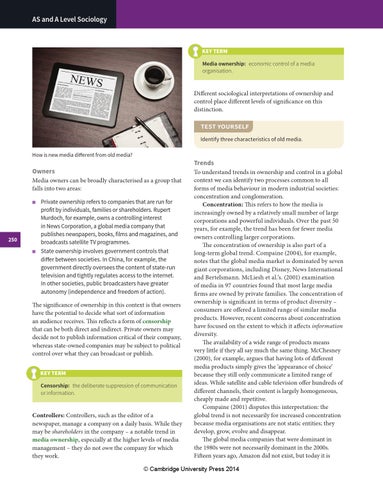AS and A Level Sociology
KEY TERM Media ownership: economic control of a media organisation.
Different sociological interpretations of ownership and control place different levels of significance on this distinction.
TEST YOURSELF Identify three characteristics of old media. How is new media different from old media?
Owners Media owners can be broadly characterised as a group that falls into two areas: ■
250 ■
Private ownership refers to companies that are run for profit by individuals, families or shareholders. Rupert Murdoch, for example, owns a controlling interest in News Corporation, a global media company that publishes newspapers, books, films and magazines, and broadcasts satellite TV programmes. State ownership involves government controls that differ between societies. In China, for example, the government directly oversees the content of state-run television and tightly regulates access to the internet. In other societies, public broadcasters have greater autonomy (independence and freedom of action).
The significance of ownership in this context is that owners have the potential to decide what sort of information an audience receives. This reflects a form of censorship that can be both direct and indirect. Private owners may decide not to publish information critical of their company, whereas state-owned companies may be subject to political control over what they can broadcast or publish. KEY TERM Censorship: the deliberate suppression of communication or information.
Controllers: Controllers, such as the editor of a newspaper, manage a company on a daily basis. While they may be shareholders in the company – a notable trend in media ownership, especially at the higher levels of media management – they do not own the company for which they work.
Trends To understand trends in ownership and control in a global context we can identify two processes common to all forms of media behaviour in modern industrial societies: concentration and conglomeration. Concentration: This refers to how the media is increasingly owned by a relatively small number of large corporations and powerful individuals. Over the past 50 years, for example, the trend has been for fewer media owners controlling larger corporations. The concentration of ownership is also part of a long-term global trend. Compaine (2004), for example, notes that the global media market is dominated by seven giant corporations, including Disney, News International and Bertelsmann. McLiesh et al.’s. (2001) examination of media in 97 countries found that most large media fi rms are owned by private families. The concentration of ownership is significant in terms of product diversity – consumers are offered a limited range of similar media products. However, recent concerns about concentration have focused on the extent to which it affects information diversity. The availability of a wide range of products means very little if they all say much the same thing. McChesney (2000), for example, argues that having lots of different media products simply gives the ‘appearance of choice’ because they still only communicate a limited range of ideas. While satellite and cable television offer hundreds of different channels, their content is largely homogeneous, cheaply made and repetitive. Compaine (2001) disputes this interpretation: the global trend is not necessarily for increased concentration because media organisations are not static entities; they develop, grow, evolve and disappear. The global media companies that were dominant in the 1980s were not necessarily dominant in the 2000s. Fifteen years ago, Amazon did not exist, but today it is
© Cambridge University Press 2014
